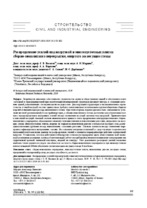| dc.contributor.author | Босаков, С. В. | |
| dc.contributor.author | Мордич, А. И. | |
| dc.contributor.author | Карякин, А. А. | |
| dc.contributor.author | Сонин, С. А. | |
| dc.contributor.author | Дербенцев, И. С. | |
| dc.coverage.spatial | Минск | ru |
| dc.date.accessioned | 2019-04-16T09:36:08Z | |
| dc.date.available | 2019-04-16T09:36:08Z | |
| dc.date.issued | 2019 | |
| dc.identifier.citation | Распределение усилий под нагрузкой в многопустотных плитах сборно-монолитного перекрытия, опертого на несущие стены = Distribution of Load Forces in Hollow Core Slabs of Precast Solid Floor Supported on Bearing Walls / С. В. Босаков [и др.] // Наука и техника. – 2019. – № 2. – С. 93-103. | ru |
| dc.identifier.uri | https://rep.bntu.by/handle/data/51846 | |
| dc.description.abstract | Потребности снижения себестоимости строительства жилых и общественных зданий и обеспечения в них свободной и трансформируемой при эксплуатации планировочной структуры вызывают интерес к стеновым системам зданий, выполняемым с большим шагом несущих стен. Для сокращения трудозатрат и повышения темпа строительства в такой несущей системе здания также требуются максимальное использование крупногабаритных сборных изделий и минимизация расхода монолитного бетона. При этом сборные изделия должны быть заменяемы по условиям местной (региональной) базы стройиндустрии, а объема монолитного бетона достаточно для обеспечения полного перераспределения внутренних усилий между элементами несущей системы под нагрузкой. Применительно к описанной несущей стеновой системе многоэтажного здания в статье представлена конструкция плоского сборно-монолитного перекрытия, образованного многопустотными плитами и монолитными ригелями, опираемого на несущие стены. Многопустотные плиты, опертые по торцам на монолитные ригели в плоскостях несущих стен, размещены плотными группами между монолитными связевыми ригелями. Плотные контакты между элементами перекрытия зафиксированы внутренними связями. На основании натурных испытаний и существующих теоретических положений получены новые данные по распределению усилий в элементах перекрытия при действии вертикальной нагрузки. Установлено, что под действием этой нагрузки в плоскости перекрытия вдоль обеих главных осей возникают реактивные распорные усилия, обеспечивающие работу каждой группы многопустотных плит в перекрытии как эффективной цельной сплошной пластины, опертой по контуру. Учет реактивных распорных усилий позволяет наиболее точно оценить несущую способность и жесткость сборно-монолитного перекрытия и при многопустотных плитах толщиной 220 мм обеспечить увеличение шага несущих стен до 8 м и более. | ru |
| dc.language.iso | ru | ru |
| dc.publisher | БНТУ | ru |
| dc.title | Распределение усилий под нагрузкой в многопустотных плитах сборно-монолитного перекрытия, опертого на несущие стены | ru |
| dc.title.alternative | Distribution of Load Forces in Hollow Core Slabs of Precast Solid Floor Supported on Bearing Walls | ru |
| dc.type | Article | ru |
| dc.identifier.doi | 10.21122/2227-1031-2019-18-2-93-103 | |
| local.description.annotation | The need to cut construction cost of residential and public buildings and provide them with a free and transformable planning structure during their operation cause interest in building wall systems with a large step of bearing walls. In order to reduce labor inputs and increase rate of construction in such building load-bearing system it is also necessary to maximize the use of large-sized prefabricated products and minimize consumption of in-situ concrete. In this case prefabricated products should be substituted according to the conditions of local (regional) construction industry base and volume of in-situ concrete must be sufficient to ensure a complete redistribution of internal forces between elements of the bearing system under load. As for the described bearing wall system of a multi-storey building the paper presents a flat precast solid floor formed by hollow-core slabs and monolithic crossbars supported by load-bearing walls. The hollow-core slabs supported at the ends on cast-in-place crossbars in the planes of bearing walls are arranged in dense groups between cast-in-place braced cross-beams. Dense contacts between overlapping elements are fixed by internal bonds. New data on distribution of forces in floor elements under the action of a vertical load have been obtained on the basis of full-scale tests and existing theoretical assumptions. It has been established that due to this load reactive thrust forces ensuring an operation of every hollow-core slab group in the floor as an effective solid plate supported along the contour have been originated in the floor plane along two main axes. Calculation of the reactive thrust forces makes it possible more accurately to assess a load-bearing capacity and rigidity of the precast solid floor and to increase a step of bearing walls up to 8 m and more while having hollow-core slabs with a thickness of 220 mm. | ru |

